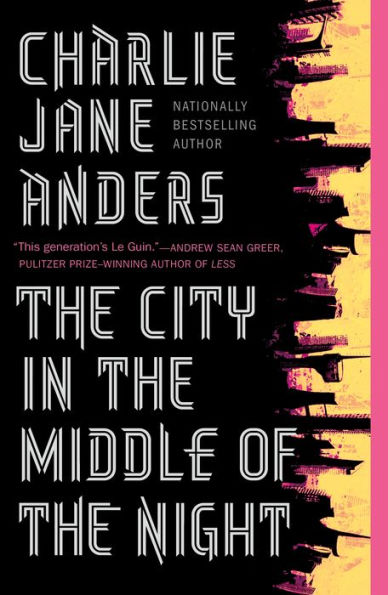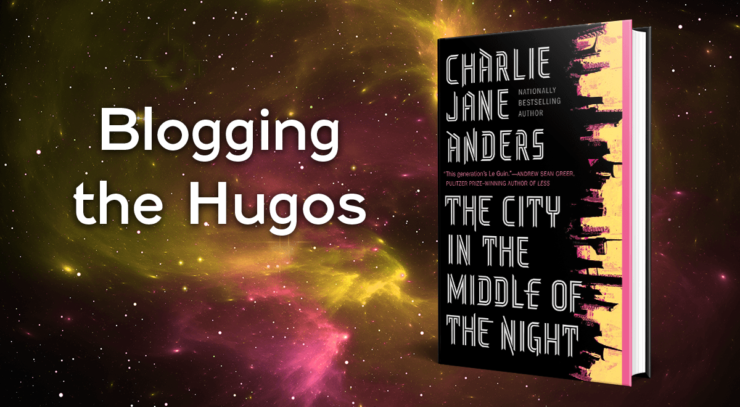In the lead-up to the 2020 Hugo Awards, we’re taking time to appreciate this year’s best novel Finalists, and what makes each of them great.
I adored Charlie Jane Anders’ first novel, All the Birds in the Sky—not that this puts me in rarefied company; it did win the Nebula Award for Best Novel and was named one of the 10 best novels of 2016 by Time magazine. And beyond its proclivity for genre mashing (the story follows a pair of young protagonists as they come of age, one of them a scientific genius capable of building a wristwatch-sized time machine, the other a budding witch who can speak to animals) or its ripped-from-tomorrow’s headlines plot (which brings us to the brink of the climate apocalypse and beyond), I loved it for its narrative voice. Laden with the author’s understated, wry wit—honed across a decade in the internet trenches as the editor of the science and science-fiction website io9—and littered with sarcasm and pop culture references, it reads like a book written for people who came of age alongside the internet (raises hand).
Anders’ follow-up, The City in the Middle of the Night—her second consecutive novel to earn a Hugo nomination—looks, on paper, like a very different animal indeed. Instead of a near-future Earth, it is set centuries in the future, on an alien world colonized by humans. Instead of mining tropes from both sides of the genre divide, it sits firmly in the camp of New Wave-era, Ursula K. Le Guin-style science fiction. And contemporary pop culture references in this context would certainly be… a choice.
And yet—this is unmistakably a work by the same author, a writer with precise control over her instrument. It’s also an even better book: more ambitious, more cohesive, more sure of itself, and just as easy to fall for. I suppose I should also point out that it seems to be just as divisive: both of Anders’ novels share nearly the same reader score on Goodreads, a slightly tepid 3.5—the scores pulled in both directions by as many raves as pans.
Buy the Book


The City in the Middle of the Night
Framed as an anthropological artifact discovered and translated even further in the future from when it is set (though that curious choice ultimately has little impact on the novel), The City in the Middle of the Night is primarily the story of Sophie, one of the human colonists inhabiting January, a tidally locked world. One half of the planet forever faces the sun, the other half is forever turned away from it. Either side is wholly inhospitable to humans, but there is a thin line in between them—where the planet’s hemispheres meet—that can sustain life. As a result, life on January is precarious, especially because the colonists are stranded on the planet, unable to contact their generation ship, and what tech remains to them is slowly failing. These circumstances have pushed the people of Sophie’s home city, Xiosphant, to adhere to strict curfews that regiment their days as if they are cogs in a machine. Shutters raise and lower at prearranged times to create a semblance of passing days in the city of eternal twilight, and their devotion to the clock becomes almost cult-like.
Duality is a recurring theme. Even on this drastically inhospitable planet, there are haves and have-nots, and quiet, self-effacing Sophie is definitely in the latter camp. She is the equivalent of a scholarship student at the gymnasium, the institution churning out the next generation of the Xiosphanti elite. She finds herself irresistibly drawn to Bianca, one of the bourgeoisie at the school, a girl for whom the poverty and struggle facing the majority of the city’s population is little more than a cause célèbre to allow her to rebel against her parents. When Bianca pulls a prank that draws the attention of the local police, Sophie impulsively takes the blame, but the infraction that might have resulted in a slap on the wrist for the privileged girl becomes tantamount to a death sentence for Sophie. Without a chance to defend herself, Sophie is cast out into the night—into the cold lifelessness of the planet’s dark side—where she will surely die.
But she doesn’t. For out on the ice, she encounters one of the Gelet—the planet’s impossible native inhabitants, a creature of fur and tentacles that the humans have been taught to fear and to kill. And, upon touching the alien being, Sophie discovers that their species is sentient, and that they can communicate, after a fashion, via a form of telepathy that opens her mind to the enormity of the world she inhabits only a small sliver of—a world that she discovers is dying, and not slowly. Shaken by the encounter, Sophie makes her way back into the city, determined to bring word of what she has discovered to others, if only she can make them understand.
Sophie’s story is only half of the tale—duality, remember? In alternating chapters, we also meet Mouth, who grew up cityless, part of a nomadic tribe. When she was young, she saw everyone she knew or cared about killed—victims of the planet’s hostile environment—and now makes a living traveling with a band of traders between January’s few human settlements. Mouth is the anthesis of everything that is regimented and ordered in Xiosphant—wild, rebellious, and brash. When their paths cross, Mouth is disgusted by Sophie’s apparent timidness, but only because she is blind to the resolve she carries within.
This is only the setup to a novel that travels far afield in its relatively slim page count. It is equal parts a work of social science fiction, exploring issues of environmentalism and political systems and contrasting ways of thinking—there exists also the city of Argelo, the hedonistic anthesis of Xiosphant—and a tale of first contact, delving into the extremely strange culture of the Gelet. It is a tour of an invented landscape, with breathless, action-packed centerpieces that take us to either side of January’s deadly surface and deep into a truly alien city.
But it is also a coming-of-age story for Sophie and Mouth, both of whom must learn to overcome their past traumas and the ingrained ways of thinking that have dampened their abilities to live in the world, such as it is. Particularly in Sophie’s relationship with Bianca does the novel feel most like Anders’ earlier work—not just her novels but her wealth of short fiction, which tends to explore high-concept premises through the lens of deeply flawed, entirely relatable characters. The girls are polar opposites but codependent, and their deep friendship—which briefly blossoms into something more—is bad for them both, but they each have trouble realizing it. Even in a landscape as strange and hostile as the planet January, growing up looks achingly familiar: painful and confusing and hard as hell.
Joel Cunningham was the founding editor of the B&N Sci-Fi & Fantasy Blog (RIP), where he explored the galaxy for 5 years, picking up a Hugo Award (well, tangentially) along the way. He’s now managing editor of Lifehacker, which means he’s managing at least one thing nowadays. He lives in an apartment in Brooklyn with his wife and two children and hopes to go outside again someday. He tweets @joelevard.










